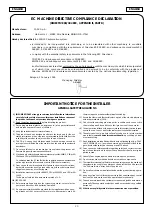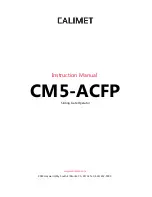
E
N
G
L
IS
H
36
4.6 - EXTERNAL AERIAL
We suggest to use the external aerial (model: ANS433) in
order to guarantee the maximal range.
Connect the antenna hot pole to terminal
A2 (ANT)
of the
control unit and the shield to terminal
A1 (ANT-)
.
4.7 - LOW VOLTAGE LIGHT OUTPUT
The PD13 control unit has a 24 VDC output that allows
connection of a maximum load of 3 W.
This output can be used to connect a warning light, indicating
the status of the gate, or for a low voltage flashing light.
Connect the low voltage signal light or flashing light wires to
terminals
E4 (+)
and
E5 (-)
.
CAUTION: Pay attention to the polarity of the connected
device if necessary.
4.8 - COURTESY LIGHTS
Thanks to the output COURTESY LIGHT the control unit
allows the connection of an electric appliance (e.g. courtesy
light or garden lights), controlled automatically or by means of
the special transmitter key.
The courtesy light terminals can be alternatively used for a 230V
flashing light with integrated flasher.
The output COURTESY LIGHT is a simple N.O. contact with no
power supply.
Connect the cables to terminals
B1
and
B2
.
4.9 - POWER SUPPLY
The control unit must be fed by a 230V-50Hz electric line,
protected by a differential magnetothermal switch complying
with the law provisions in force.
Connect the power supply wires to terminals
L
and
N
on the
board located next to the transformer.
Connect the earth cable to terminal
4.10 - BATTERY POWER
In the case of an electricity black-out, the device may be powered
using a battery pack (accessory code 161212).
The battery pack should be housed in the specific seating, as
shown in the figure.
Connect the battery pack connecter to the BATTERY terminals on
the control unit.
4.11 - PLUG IN RECEIVER
PD13 control unit is suitable for plugging in a MRx receiver
having a high-sensitivity super-heterodyne architecture.
MRx module receiver is provided with 4 channels and each of
them is suitable for a command of PD13 control unit:
• CHANNEL 1
쩚쩛
START
• CHANNEL 2
쩚쩛
PEDESTRIAN START
• CHANNEL 3
쩚쩛
STOP
• CHANNEL 4
쩚쩛
COURTESY LIGHT
NOTE: Before programming 4 channels and function
logics read carefully the instructions of MRx.
4.12 - ADI INTERFACE
The ADI (Additional Devices Interface) interface of the control
unit PD13 allows the connection to V2 optional modules.
Refer to V2 catalogue or to the technical sheets to see which
optional modules with ADI interface are available for this control
unit.
m
WARNING: Please read the instructions of each single
module to install the optional modules.
For some devices, it is possible to configure the mode for
interfacing with the control unit; in addition, it is necessary to
enable the interface so that the control unit can process the
signals arriving from the ADI device.
Please refer to the
i.A di
programming menu to enable the ADI
interface and access the device configuration menu.
ADI devices use the display of the control unit to issue alarms or
display the configuration of the control unit.
NOTE:
If the ADI interface is not enabled (no device
connected), the segments remain turned off.
The device connected to the Adi interface is able to signal to the
control unit three alarm signals, which are displayed on the
control unit display as follows:
•
PHOTOCELL ALARMS
-
the upper segment comes on
:
the gate stops moving, when the alarm stops opening restarts.
•
EDGE ALARM
-
the lower segment comes on
:
inverts motion of the gate for 3 seconds.
•
STOP ALARM
-
both segments start flashing
:
the gate stops and cannot restart until the alarm stops.
• SLAVE - segment steadily lit: it is used by the optional module
SYNCRO to indicate that the control unit is configured as
SLAVE.













































